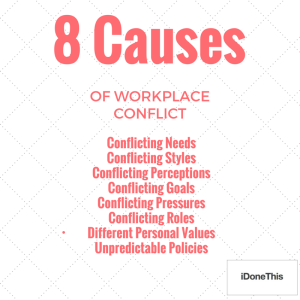
The workplace is for work. You’re here to get things done, grow the business, improve the world and get better at whatever it is that you do.
It’s not a place for squabbling with coworkers, managers and subordinates. But that’s what seems to happen. Workplace conflict is everywhere, eating up productivity and taking precious time away from the things that really matter.
It doesn’t have to be this way. The causes of workplace conflict are recognizable. In separate articles on workplace conflict, psychologists Art Bell and Brett Hart identified eight common causes of conflict in the workplace. Think about the conflicts you’ve had in the workplace. You’d be hard-pressed to find on you can’t trace back to one of these root causes.
It’s important to see workplace conflict this way, as a symptom of a great structural problem.
That argument with the boss over coming in on Saturday isn’t really about coming in on Saturday. It’s about the misaligned expectations, structural problems, and poor communication that led you to have to come in on Saturday. In other words, the problem is bigger than the problem.
At best, it’s a symptom of a greater failure.
Thankfully, smart and innovative companies are changing the way we work — and eradicating the causes of workplace conflict at the source. Here’s a look at the eight causes and what great companies are doing about them.
Cause 1. Conflicting Needs
Resources are scare. That’s what makes them valuable. The workplace is ground zero for resource scarcity. Because if what your company made was free and abundant, you wouldn’t have a business model. All this workplace scarcity — for your time, your boss’s time, office supplies — leads to conflict.
These limited resources aren’t always physical — recognition and praise are just as valuable to employees, and often just as rare as other resources.
Solution: Google
This scarcity problem escalates when power-wielding managers horde resources and dole them out in crumbs like feeding pigeons in the park. Google solves this by highly valuing how employees view managers. The company regularly surveys workers about their managers. Those that are seen as hoarding resources and not properly allocating time don’t last long at Google.
As for recognition and praise, these are the kind of ephemeral resources that are literally free, infinite, and have a gigantic impact on employees. Establish a managerial training program — with regular reminders throughout the year — that managers should take time to recognize the employees and coworkers that are doing well.
Cause 2. Conflicting Styles
People are different from one another. It doesn’t look that way on a spreadsheet, but get a bunch of people in a room, working on the same project, and it’s immediately clear that different people have different styles. Bad companies punish people for thinking or acting differently. It becomes like high school — there are cliques, there are outcasts, there’s drama.
Solution: Travis CI
German company Travis CI is working to evolve the way individualism is thought of in the workplace. The company doesn’t just celebrate diversity, they actively evaluate their own understanding of culture and whether it’s working. This keeps them from falling into the trap of expecting everyone to act the same, or, not understanding just how important culture is. Or as AirBNB CEO Brain Chesky put it: “All problems will come and go. But culture is forever.”
Cause 3. Conflicting Perceptions
TwTwo or more people can view the same event in a totally different way. This mismatch of perceptions can lead to a lot of workplace conflict. This happens all the time in meetings, where one message is shared verbally with many people. Often each person will have their own interpretation of what the directive means.
What this creates is confusion, where team members don’t realize which projects are priority and which actionable items need to be taken care of. It also muddies the water on who is supposed to take care of the action items, which can leave projects stalled.
Solution: I Done This
Many meetings — like the daily standup — can be replaced entirely. We build and use I Done This to keep meetings to a minimum and share information asynchronously. It’s a lot harder to misunderstand something when it’s written down somewhere for everyone to see.
Organizing these asynchronous documents is key, and making them available to all of the team members at any time should be job one. Lastly, if you do a Power Point deck or any kind of presentation, make sure to send it to all team members after the meeting and also upload it to your resource documents for further perusal in the future.
Cause 4. Conflicting Goals
There’s nothing worse than being laser focused on achieving one thing, and working alongside someone who is focused on something entirely different. When different employees’ goals don’t align with each other, pretty soon the employees aren’t agreeing with each other either.
They’re working on different projects, or worse, they’re all working on the same project but at cross-purposes. Whether they’re financial goals, culture goals, or customer goals, the only thing worse than a lack of communication is bad communication.
Solution: Facebook
Focus on one big thing, not many. In Facebook’s early days, the ultimate goal was to grow the total number of users. And ideas or initiatives that did not serve that goal weren’t even discussed. Yes, there were other sub-goals and smaller tasks that served the big goal. But they all served the one goal. If your company is not aligned around one main goal — which everyone can rally behind — conflicts will arise.
Much of this can be stopped at the project management level, which is why it’s so important to embrace the tools that can make the process go smoothly.
Cause 5. Conflicting Pressures
Just as conflicting goals will set you up for failure, conflicting pressures on employees will lead to conflicts. When one manager asks an employee to do one thing, and another asks for something else that conflicts with that, serious problems arise.
And if neither manager is good at sharing or communication, the pressures of this conflict can nudge even the most stalwart employee into updating their resume.
Solution: Flat management Structures
Buffer got rid of the pressures of multiple managers by getting rid of managers altogether. In 2014 the company switched to a fully self-managed and self-organized team. As Co-Founder Leo Widrich wrote: “There’re no managers or bosses and everyone on the team is encouraged to work freely on projects they are most compelled to work on, that they feel they have expertise and skill and that they feel Buffer needs at this point.”
Forbes recently published an article about the benefits of flat hierarchies, and how they actually increase employee investment and entrepreneurship.
The idea is to create virtuous cycle of positive reinforcement instead of a work flow based off pain and shame.
Cause 6. Conflicting Roles
No matter how much you might be an expert in X, at some point someone’s going to ask you to do Y. Who knows why this happens. But it does all the time. Even worse, there might be the world’s foremost Y expert sitting two desks over. Now he’s upset that you’re doing it wrong, you’re upset that you shouldn’t be doing this task. It’s a big mess.
Solution: Google
In it’s early years, Google’s founders struggled with how to bring management layers into the company. They didn’t want to ruin the feeling of Google being a workplace built by engineers and for engineers. Managers adding too many little tasks would lead to someone’s toes getting stepped on, and someone being asked to do some little task that someone else was better suited for. So Google kept a high ratio of engineers per manager, with each manager overseeing around 30 engineers.
With that many people to oversee, it’s impossible to dole out small tasks. The managers are forced to focus on big picture problems and motivating their employees.
Cause 7. Different Personal Values
Personal values are a complex and emotional topic. In a workplace, it’s likely that people of different backgrounds, upbringings and religions are coming together in tight quarters. These values can sometimes rub up against one another and start fires.
And the goal shouldn’t be to just get a team that all thinks the same or is from the same background. That’s a recipe for redundancy at best and stagnation at worst.
Solution: Apptentive
The Seattle company Appetitive has transformed its previously-poor diversity numbers and embraced diversity in a way that works. CEO Robi Ganguly told Fast Company that getting the current team on board with rethinking diversity is extra important. You don’t want current employees thinking the leaders will be hiring less qualified people for the sake of diversity.
“That should never be the message,” Ganguly said. “What you want to communicate is that it’s important to have diversity, build better products, build better teams because you have diverse thinking.”
It isn’t about checkboxes, it’s about finding a team that peacefully communicates and coexists while at the same time bringing fresh new ideas to the table.
Cause 8. Unpredictable Policies
Here’s the problem with workplace policies: Nobody reads them. You’re handed a thick stack of boring jargon on your first day (along with 200 other things to fill out) and you never get around to reading it. Even worse, policies change and shift with little warning.
Or perhaps an email is sent from HR and promptly ignored by a busy workforce. At best there’s a meeting about HR policy changes. But it’s the world’s most boring meeting, so everyone just peers under the table at their phones. Maybe you get a new Candy Crush high score out of it, but there’s no way you remember the new XYZ policy.
Solution: Valve
The game company Valve created their Handbook For New Employees (subtitle: “A fearless adventure in knowing what to do when no one’s there telling you what to do”) as a beautifully-illustrated comic adventure. Even if you don’t work there, it’s a blast to read. And I’m guessing nobody every said that about your corporate policy booklet.
If you liked this blog post, you’ll love our ebook called What You Don’t Know About Management.


